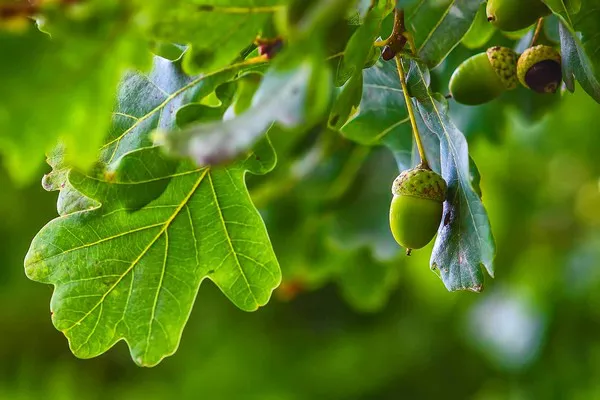The United Kingdom, renowned for its picturesque landscapes and diverse ecosystems, boasts a rich variety of native and non-native tree species. These trees contribute not only to the visual allure of the countryside but also play a vital role in the ecological balance of the region. In this comprehensive exploration, we delve into the ten most common trees found across the UK, shedding light on their distinctive features, ecological significance, and cultural connections.
The 10 Most Common Trees in the UK
1. Oak Trees (Quercus spp.)
Distinctive Features:
The mighty Oak, an iconic symbol of strength and endurance, stands tall as one of the most prevalent trees in the UK. With various species, such as the Pedunculate Oak (Quercus robur) and Sessile Oak (Quercus petraea), these deciduous trees dominate both lowland and upland landscapes. Recognizable by their lobed leaves and acorns, Oaks have been revered throughout history for their robust timber and cultural symbolism.
Ecological Significance:
Oaks are biodiversity hotspots, supporting a myriad of flora and fauna. Their acorns serve as a vital food source for wildlife, including deer and squirrels. The Oak’s sturdy wood has been traditionally utilized in shipbuilding and construction, showcasing the practical importance of this majestic tree.
2. Birch Trees (Betula spp.)
Distinctive Features:
The graceful Birch tree graces the UK with its slender form and distinctive white bark. The Silver Birch (Betula pendula) is particularly common, recognizable by its pendulous branches and delicate leaves. The Downy Birch (Betula pubescens) is another native species, often found in wetter environments.
Ecological Significance:
Birch trees are pioneers in ecological succession, often the first to colonize barren landscapes. Their catkins provide an early source of nectar for pollinators, and the trees’ adaptability allows them to thrive in various soil types. Birch wood is valued for its versatility, used in crafting furniture and tools.
3. Beech Trees (Fagus sylvatica)
Distinctive Features:
The Beech tree, with its smooth gray bark and glossy leaves, graces many woodlands across the UK. Known for its dense canopy and copper-colored leaves in autumn, the European Beech (Fagus sylvatica) is a deciduous giant that adds elegance to the British countryside.
Ecological Significance:
Beech trees contribute to the biodiversity of woodlands, supporting a range of fungi and invertebrates. Their nuts, known as beechmast, are a crucial food source for wildlife, including deer and wild boar. Beech wood, with its fine grain, is employed in crafting furniture and utensils.
4. Scots Pine (Pinus sylvestris)
Distinctive Features:
The only native pine species in the UK, the Scots Pine, stands out with its distinctive orange-brown bark and long needles. Often found in the Scottish Highlands, these evergreen trees can withstand harsh conditions, making them a resilient feature of the British landscape.
Ecological Significance:
Scots Pines contribute to forest ecosystems by providing habitat for various bird species and mammals. Their needles create acidic soil conditions, influencing the plant species that thrive in their vicinity. The timber of Scots Pine is prized in construction and joinery.
5. Rowan or Mountain Ash (Sorbus aucuparia)
Distinctive Features:
The Rowan, also known as Mountain Ash, is a small deciduous tree celebrated for its vibrant orange berries and feather-like leaves. Commonly found in upland areas, this tree adds a splash of color to the landscape.
Ecological Significance:
Rowan berries are a crucial food source for birds, especially during winter. The tree’s ability to thrive in challenging environments contributes to the ecological resilience of upland habitats. Rowan wood, though not extensively used, is occasionally employed in crafting small items.
6. Holly (Ilex aquifolium)
Distinctive Features:
The Holly, with its glossy, spiky leaves and vibrant red berries, is an evergreen icon of winter. This native tree holds cultural significance, often associated with festive decorations during the holiday season.
Ecological Significance:
Holly provides valuable shelter for birds and insects, and its berries are a winter food source for thrushes and blackbirds. The tree’s dense foliage also offers protection for smaller mammals. Holly wood, hard and smooth-grained, is occasionally used in craftsmanship.
7. Sycamore (Acer pseudoplatanus)
Distinctive Features:
The Sycamore, a non-native species, is easily identifiable by its large, palmately lobed leaves and distinctive winged seeds. Widely distributed across the UK, this deciduous tree has integrated itself into the landscape.
Ecological Significance:
Sycamores contribute to urban and rural landscapes, providing shade and ornamental value. While not a significant wildlife resource, their seeds are consumed by various birds and small mammals. The wood is used in furniture making and as firewood.
8. Common Alder (Alnus glutinosa)
Distinctive Features:
The Common Alder, with its conical shape and serrated leaves, thrives in wetland environments. Recognizable by its catkins and small cones, this deciduous tree plays a crucial role in riparian ecosystems.
Ecological Significance:
Alders are nitrogen-fixing trees, enhancing soil fertility in waterlogged areas. Their catkins provide an early source of pollen for insects, and the tree’s decaying wood creates habitat for fungi and invertebrates. Alder timber, though not widely used, is occasionally employed in crafting small items.
9. Wild Cherry (Prunus avium)
Distinctive Features:
The Wild Cherry, also known as the Bird Cherry, is a deciduous tree celebrated for its profusion of white flowers in spring. The tree’s red cherries are a distinctive feature, attracting both wildlife and human foragers.
Ecological Significance:
Wild Cherry blossoms provide nectar for pollinators, contributing to the overall health of ecosystems. The cherries are consumed by birds, and the tree’s adaptability allows it to thrive in a variety of habitats. Wild Cherry wood is valued in furniture making and as a decorative material.
10. Common Hazel (Corylus avellana)
Distinctive Features:
The Common Hazel, a small deciduous tree, is known for its distinctive catkins and toothed leaves. Often found in woodlands and hedgerows, this versatile tree has both ecological and economic significance.
Ecological Significance:
Hazel provides habitat for various wildlife, and its nuts, known as hazelnuts or cobnuts, are consumed by birds and small mammals. The tree’s adaptability makes it a valuable component of diverse ecosystems. Hazel wood, flexible and durable, is used in crafts such as hurdle making.
11. White Willow (Salix alba)
Distinctive Features:
The White Willow, a native tree with slender branches and elongated leaves, thrives in wetland environments. Often associated with riverbanks, this deciduous tree has been historically used for various purposes.
Ecological Significance:
White Willows stabilize riverbanks and provide habitat for numerous aquatic species. Their catkins are an early food source for bees, and the tree’s flexible branches create suitable nesting sites for birds. Willow wood is traditionally used in basketry and fencing.
See Also: The World’s 10 Largest Trees
In conclusion, the UK’s diverse tree species contribute not only to the visual charm of the landscape but also play integral roles in ecological systems. Understanding the distinctive features and ecological significance of these common trees enhances our appreciation for the intricate tapestry of nature that surrounds us. Whether in woodlands, urban parks, or countryside hedgerows, these trees weave a story of resilience, adaptability, and the interconnectedness of all living things.
You Might Be Interested In:























